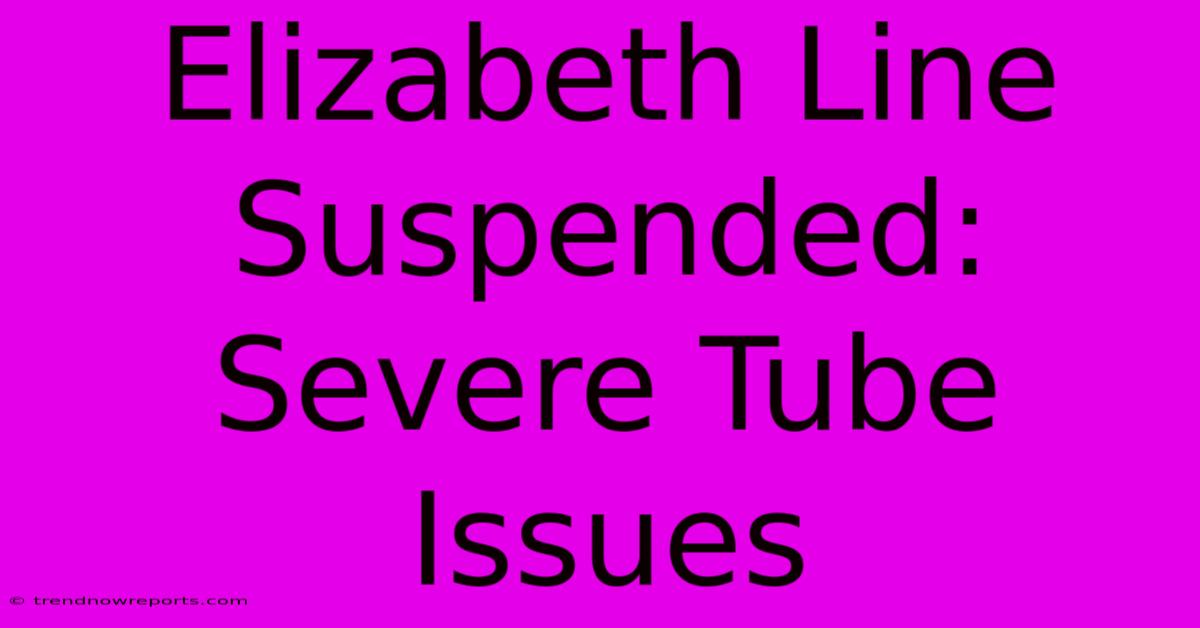Elizabeth Line Suspended: Severe Tube Issues

Discover more detailed and exciting information on our website. Click the link below to start your adventure: Visit My Website. Don't miss out!
Table of Contents
Elizabeth Line Suspended: Severe Tube Issues - A Commuters Nightmare!
Ugh, talk about a Monday morning! Remember that time the Elizabeth Line went completely kaput? Yeah, I was stuck on that train for like, an hour. Total nightmare. Seriously, it was one of those moments where I questioned all my life choices. Like, why did I even move to London again? But hey, I’m gonna tell you all about it, ‘cause honestly, it was a masterclass in how not to handle a major transport disruption. And, bonus, I learned a few things about SEO along the way, so stick around.
The Day the Elizabeth Line Died (Almost)
So, picture this: It’s rush hour, I'm already running late (typical), crammed onto the Elizabeth Line, scrolling through Insta, you know the drill. Suddenly, the train screeches to a halt. Not a gentle stop, mind you, a full-on, emergency brake situation. Panic started to rise—you could practically feel the collective anxiety in the carriage.
The announcements were…well, let’s just say they were less than reassuring. Something vague about a "signal failure." Seriously? Signal failure? In this day and age? I mean, we're talking about one of the most modern underground lines in the world, right? I almost expected a guy to pop up and yell, "Sorry folks, the steam engine's runnin' a bit low on coal!"
What Went Wrong (And How to Avoid a Similar PR Disaster)
This whole debacle really highlighted the importance of crisis communication. The lack of clear, concise information just fueled the speculation and panic. People were freaking out; social media was blowing up with complaints and memes. The whole thing felt horribly unprofessional.
Here’s what they should have done differently:
- Real-time updates: Constant, clear updates through the app, on-board announcements, and social media would have been KEY.
- Detailed explanations: Instead of vague terms, provide specifics about the issue, estimated wait times, and alternate transportation options. People are more patient if they know what’s going on.
- Proactive communication: Don't wait for people to panic; get ahead of the story. A quick tweet acknowledging the issue and promising updates would have been a huge help.
It was a total PR disaster, honestly. The Elizabeth Line’s reputation took a major hit that day.
SEO Lessons Learned (From a Total Train Wreck)
Ironically, all this chaos provided some amazing SEO lessons. I mean, who knew a train breakdown could teach you about content marketing? But here’s the thing: the whole event generated a TON of online chatter. This is where you can actually use negative events to your advantage.
- Keyword research is gold: Terms like "Elizabeth Line delay," "Elizabeth Line disruption," and "Elizabeth Line signal failure" were trending. Had I been savvy enough, I could’ve created a helpful blog post answering common questions and offering advice (like what I’m doing now, ha!).
- Content is king (or queen!): Providing accurate, helpful information in a time of crisis can massively boost your website traffic. Think about it: people were desperate for info.
- User experience matters: A site that’s easy to navigate and provides quick answers will get way more visits. I know I wouldn't have bothered with a site that was slow or confusing during the chaos.
So yeah, that was my day on the Elizabeth Line from hell. But hey, at least I got a killer blog post out of it, right? Hopefully, Transport for London (TfL) learns from their mistakes; until then, always have a backup plan when travelling on public transport! And always remember to check your favorite websites (like mine, naturally!) for up-to-date travel info. You never know when another "signal failure" might strike.

Thank you for visiting our website wich cover about Elizabeth Line Suspended: Severe Tube Issues. We hope the information provided has been useful to you. Feel free to contact us if you have any questions or need further assistance. See you next time and dont miss to bookmark.
Featured Posts
-
Brand Ed Launches Manchester City Sports School
Nov 27, 2024
-
Aberdeen Cancels St Johnstone Fan Zone Alcohol
Nov 27, 2024
-
Bayern Overcomes 10 Man Psg
Nov 27, 2024
-
Ucl Simulation Sporting Beats Arsenal
Nov 27, 2024
-
Rush Hour Elizabeth Line Train Issues
Nov 27, 2024
